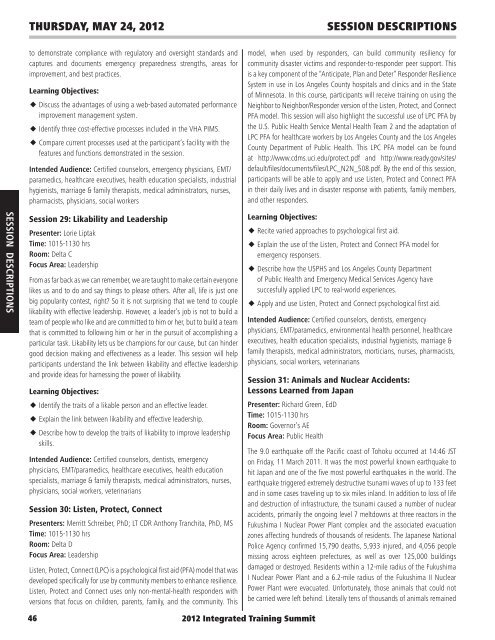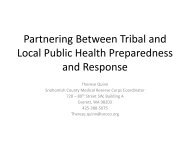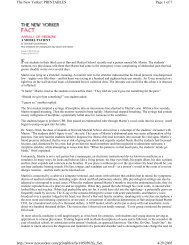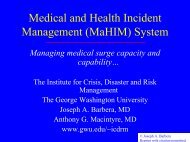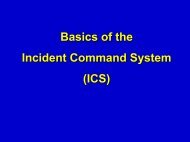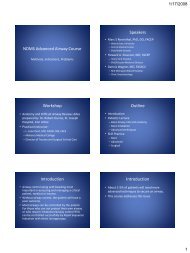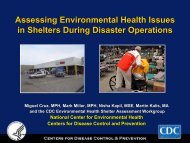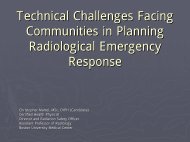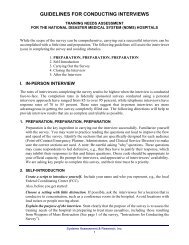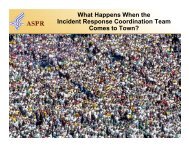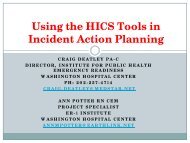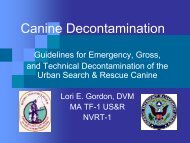THURsday, May 24, <strong>2012</strong>Session Descriptionssession Descriptionsto demonstrate compliance with regulatory and oversight standards andcaptures and documents emergency preparedness strengths, areas forimprovement, and best practices.Learning Objectives:u Discuss the advantages of using a web-based automated performanceimprovement management system.u Identify three cost-effective processes included in the VHA PIMS.u Compare current processes used at the participant’s facility with thefeatures and functions demonstrated in the session.Intended Audience: Certified counselors, emergency physicians, EMT/paramedics, healthcare executives, health education specialists, industrialhygienists, marriage & family therapists, medical administrators, nurses,pharmacists, physicians, social workersSession 29: Likability and LeadershipPresenter: Lorie LiptakTime: 1015-1130 hrsRoom: Delta CFocus Area: LeadershipFrom as far back as we can remember, we are taught to make certain everyonelikes us and to do and say things to please others. After all, life is just onebig popularity contest, right? So it is not surprising that we tend to couplelikability with effective leadership. However, a leader’s job is not to build ateam of people who like and are committed to him or her, but to build a teamthat is committed to following him or her in the pursuit of accomplishing aparticular task. Likability lets us be champions for our cause, but can hindergood decision making and effectiveness as a leader. This session will helpparticipants understand the link between likability and effective leadershipand provide ideas for harnessing the power of likability.Learning Objectives:u Identify the traits of a likable person and an effective leader.u Explain the link between likability and effective leadership.u Describe how to develop the traits of likability to improve leadershipskills.Intended Audience: Certified counselors, dentists, emergencyphysicians, EMT/paramedics, healthcare executives, health educationspecialists, marriage & family therapists, medical administrators, nurses,physicians, social workers, veterinariansSession 30: Listen, Protect, ConnectPresenters: Merritt Schreiber, PhD; LT CDR Anthony Tranchita, PhD, MSTime: 1015-1130 hrsRoom: Delta DFocus Area: LeadershipListen, Protect, Connect (LPC) is a psychological first aid (PFA) model that wasdeveloped specifically for use by community members to enhance resilience.Listen, Protect and Connect uses only non-mental-health responders withversions that focus on children, parents, family, and the community. Thismodel, when used by responders, can build community resiliency forcommunity disaster victims and responder-to-responder peer support. Thisis a key component of the “Anticipate, Plan and Deter” Responder ResilienceSystem in use in Los Angeles County hospitals and clinics and in the Stateof Minnesota. In this course, participants will receive training on using theNeighbor to Neighbor/Responder version of the Listen, Protect, and ConnectPFA model. This session will also highlight the successful use of LPC PFA bythe U.S. Public Health Service Mental Health Team 2 and the adaptation ofLPC PFA for healthcare workers by Los Angeles County and the Los AngelesCounty Department of Public Health. This LPC PFA model can be foundat http://www.cdms.uci.edu/protect.pdf and http://www.ready.gov/sites/default/files/documents/files/LPC_N2N_508.pdf. By the end of this session,participants will be able to apply and use Listen, Protect and Connect PFAin their daily lives and in disaster response with patients, family members,and other responders.Learning Objectives:u Recite varied approaches to psychological first aid.u Explain the use of the Listen, Protect and Connect PFA model foremergency responsers.u Describe how the USPHS and Los Angeles County Departmentof Public Health and Emergency Medical Services Agency havesuccesfully applied LPC to real-world experiences.u Apply and use Listen, Protect and Connect psychological first aid.Intended Audience: Certified counselors, dentists, emergencyphysicians, EMT/paramedics, environmental health personnel, healthcareexecutives, health education specialists, industrial hygienists, marriage &family therapists, medical administrators, morticians, nurses, pharmacists,physicians, social workers, veterinariansSession 31: Animals and Nuclear Accidents:Lessons Learned <strong>from</strong> JapanPresenter: Richard Green, EdDTime: 1015-1130 hrsRoom: Governor’s AEFocus Area: Public Health<strong>The</strong> 9.0 earthquake off the Pacific coast of Tohoku occurred at 14:46 JSTon Friday, 11 March 2011. It was the most powerful known earthquake tohit Japan and one of the five most powerful earthquakes in the world. <strong>The</strong>earthquake triggered extremely destructive tsunami waves of up to 133 feetand in some cases traveling up to six miles inland. In addition to loss of lifeand destruction of infrastructure, the tsunami caused a number of nuclearaccidents, primarily the ongoing level 7 meltdowns at three reactors in theFukushima I Nuclear Power Plant complex and the associated evacuationzones affecting hundreds of thousands of residents. <strong>The</strong> Japanese NationalPolice Agency confirmed 15,790 deaths, 5,933 injured, and 4,056 peoplemissing across eighteen prefectures, as well as over 125,000 buildingsdamaged or destroyed. Residents within a 12-mile radius of the FukushimaI Nuclear Power Plant and a 6.2-mile radius of the Fukushima II NuclearPower Plant were evacuated. Unfortunately, those animals that could notbe carried were left behind. Literally tens of thousands of animals remained46<strong>2012</strong> Integrated Training Summit
THURsday, May 24, <strong>2012</strong>Session Descriptionsin the “no-go” zone. On 2–3 May, a group of radiation and animal rescueexperts <strong>from</strong> the United States and Japan convened to discuss the currentcrisis and develop steps to provide aid to animals inside the evacuationzone. <strong>The</strong> committee included representatives <strong>from</strong> the Japanese Ministry ofEnvironment, United States Department of Agriculture (USDA), United StatesArmy Veterinary Corps, veterinary and toxicology experts, academicians,and representatives <strong>from</strong> the International Fund for Animal Welfare. <strong>The</strong>goal of this session will be to present the response procedures and protocolsdeveloped during the Summit to monitor, evacuate, and treat animalscontaminated by radiation.Learning Objectives:u Discuss how to include animal decontamination protocols in trainingand response plans.u Apply recommendations and protocols <strong>from</strong> the Japan experience tothe participant’s comprehensive emergency management plans.u Develop protocols for recognizing safe levels of radiation whenworking with animals in or around nuclear evacuation zones.Intended Audience: Environmental health personnel, industrialhygienists, veterinariansSession 32: Cultural Components of ResponsePresenters: Debra Kreisberg, PhD, MA, BA; Guadalupe Pacheco Jr., MSWTime: 1015-1130 hrsRoom: Bayou ABFocus Area: Public Health<strong>The</strong> health sector in the United States is struggling to meet daily demandsfor service, particularly to underserved and marginalized populations.Disasters and mass casualty events exacerbate the existing strain on localhealth infrastructure. Currently, health disparities perpetuate conditions inwhich many people in need cannot access adequate healthcare, creatingdisparities that are magnified in the event of a disaster. Evidence indicatesthat diverse communities suffer disproportionately, in both physical andmental health, at every stage of a disaster. Understanding how socioculturalfactors affect the way people access healthcare systems and utilize resourcesinforms how hospitals and communities can prepare to address theseculturally-specific needs of vulnerable populations. This is fundamental to aresilient community and a sustainable health response system and must bethe foundation of public health preparedness and healthcare and hospitalresponse planning. Taken together, a robust, mixed-methods approach forcomprehensively incorporating marginalized and vulnerable populationsinto public health and hospital disaster planning is necessary, particularlyif offering a model that could promote integration between public health,hospitals, and emergency management. In addition, the implementationof culturally and linguistically appropriate services across the public health,medical, and emergency management aspects of disaster preparedness andresponse helps ensure the provision of quality emergency health services.Cultural and linguistic competency is thereby an important tool for addressingdisparities. <strong>Preparedness</strong> and response efforts should fit the varying culturalcontexts of their community. <strong>The</strong> session will demonstrate the HHS Office ofMinority Health’s Cultural Competency Curriculum for Disaster <strong>Preparedness</strong>and Crisis Response (DPCR) as an effective and adaptable learning tool forcultural competency and improving services to culturally and linguisticallydiverse populations. <strong>The</strong> DPCR is an accredited online continuing educationprogram that equips disaster personnel with the knowledge, awareness, andskills needed to provide emergency health services to diverse populations.Learning Objectives:u Examine the relevance and diversity of vulnerable populations.u Demonstrate the need for cultural and linguistically appropriateservices in disaster preparedness and crisis response.u Identify the cultural and linguistic competency concepts in disasterpreparedness and response.u Analyze common models and best practices for assessing socialvulnerability and evaluate the pros and cons of various approaches.u Discuss a video case study in terms of providing culturally andlinguistically appropriate services during a disaster.Intended Audience: Certified counselors, dentists, emergencyphysicians, EMT/paramedics, healthcare executives, health educationspecialists, marriage & family therapists, medical administrators, nurses,physicians, psychologists, social workersSession 33: Leveraging Health Information Exchangefor Disaster <strong>Preparedness</strong> and Response to ImprovePatient CarePresenters: Alison Banger, MPH; LT CDR Samuel Schaffzin, MPA;Christopher Sullivan, PhD, MATime: 1015-1130 hrsRoom: Governor’s CFocus Area: Resource Management and Patient MovementDisasters often cause the displacement of patients and providers who crossstate borders to seek safety. While people move, their medical records donot. This creates major problems in accessing and delivering ongoing healthcare. <strong>The</strong>refore, the need for integrated health information exchange, intimes of disaster and in its aftermath, is critical. In 2010, the SoutheastRegional HIT-HIE Collaboration (SERCH) initiated a Health InformationExchange (HIE) Disaster Planning Project. This project was conductedthrough the State Health Policy Consortium (SHPC), an activity of theOffice of the National Coordinator for Health Information Technology. <strong>The</strong>SHPC is funded by the Health Information Technology for Economic andClinical Health (HITECH) Act, enacted as part of the American <strong>Recovery</strong> andReinvestment Act of 2009. <strong>The</strong> primary goal of the project is to define aset of strategies for sharing health information data among the southeastand gulf states, including Alabama, Arkansas, Florida, Georgia, Louisiana,and Texas, during and following a declared disaster. <strong>The</strong> SERCH project isusing lessons <strong>from</strong> disasters such as Hurricane Katrina and more recentlythe tornadoes in Joplin, Missouri, and Tuscaloosa, Alabama, to develop astrategic plan to allow physicians and patients to access medical recordsfor healthcare treatment during and after a disaster. <strong>The</strong> SERCH team hasprepared a white paper that provides guidance and recommendationsto states who wish to understand how to integrate HIE and emergencypreparedness activities to improve patient care during a disaster. <strong>The</strong> whitepaper addresses both legal and technical issues pertaining to cross-border<strong>2012</strong> Integrated Training Summit 47session Descriptions
- Page 1 and 2: Leading from PreparednessThrough Re
- Page 3 and 4: Table of ContentsAmericans with Dis
- Page 5 and 6: Integrated Training Summit Partner
- Page 7 and 8: Focus area DescriptionsFocus Area D
- Page 9 and 10: Late Breakers & Early RisersTuesday
- Page 11 and 12: Handy Perforated Daily Agendas - De
- Page 13 and 14: Handy Perforated Daily Agendas - De
- Page 15 and 16: Handy Perforated Daily Agendas - De
- Page 17 and 18: Handy Perforated Daily Agendas - De
- Page 19 and 20: WorkshopDescriptions2012 Integrated
- Page 21 and 22: Monday, May 21, 2012Workshop Descri
- Page 23 and 24: MoNday, May 21, 2012Workshop Descri
- Page 25 and 26: MoNday, May 21, 2012Workshop Descri
- Page 27 and 28: Tuesday, May 22, 2012Workshop Descr
- Page 29 and 30: WEDNESday, May 23, 2012dMIS Worksho
- Page 31 and 32: ThurSday, May 23, 2012dMIS Workshop
- Page 33 and 34: SessionDescriptionssession Descript
- Page 35 and 36: wednesday, May 23, 2012Session Desc
- Page 37 and 38: wednesday, May 23, 2012Session Desc
- Page 39 and 40: wednesday, May 23, 2012u Provide ex
- Page 41 and 42: wednesday, May 23, 2012Session Desc
- Page 43 and 44: wednesday, May 23, 2012Session Desc
- Page 45: Thursday, May 24, 2012Session Descr
- Page 49 and 50: THURsday, May 24, 2012Session Descr
- Page 51 and 52: THURsday, May 24, 2012Session Descr
- Page 53 and 54: THURsday, May 24, 2012Session Descr
- Page 55 and 56: THURsday, May 24, 2012Session Descr
- Page 57 and 58: FRIday, May 25, 2012Session Descrip
- Page 59 and 60: Tuesday, May 22, 2012MRC WorkshopsM
- Page 61 and 62: Tuesday, May 22, 2012MRC WorkshopsL
- Page 63 and 64: Continuing Education InformationCon
- Page 65 and 66: Continuing Education InformationSes
- Page 67 and 68: Planning CommitteeDawn AnastasiaChe
- Page 69 and 70: PresentersBrian Abrahamson, BAGaylo
- Page 71 and 72: PresentersMary Massey, BSN, MA, MEP
- Page 73 and 74: Presenter DisclosuresAlliance betwe
- Page 75 and 76: 2012 Poster PresentationsMRCPoster
- Page 77 and 78: 2012 Poster PresentationsApplicatio
- Page 79 and 80: 2012 Poster PresentationsCollaborat
- Page 81 and 82: 2012 Poster PresentationsEducation
- Page 83 and 84: 2012 Poster PresentationsSpecial Co
- Page 85 and 86: Integrated Training Summit Acronym


